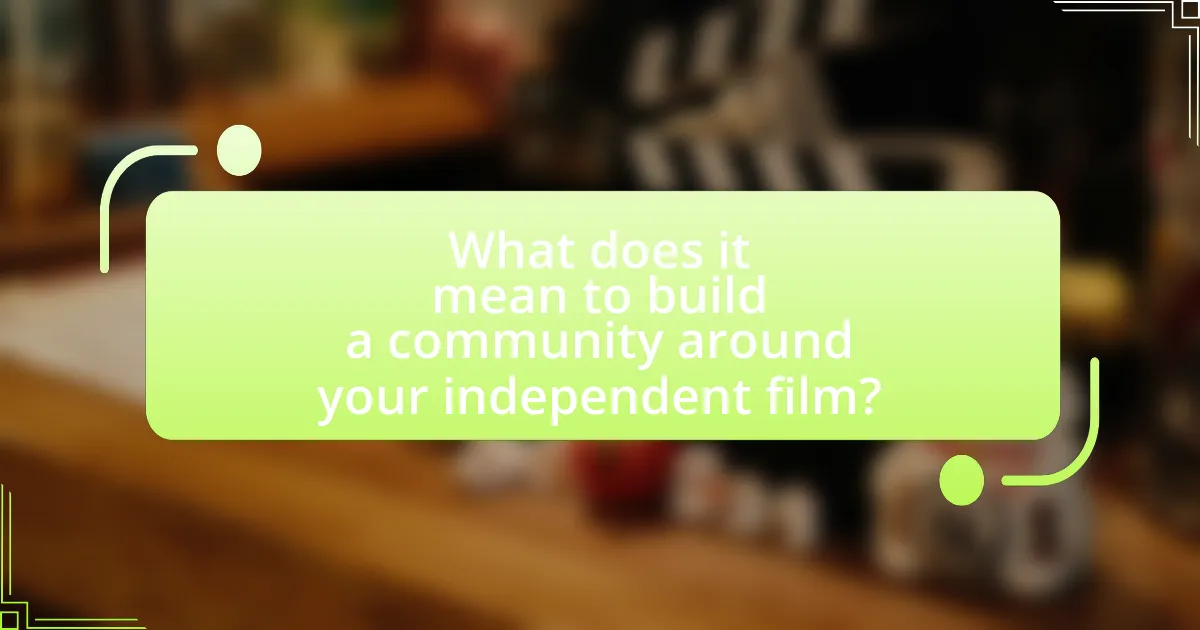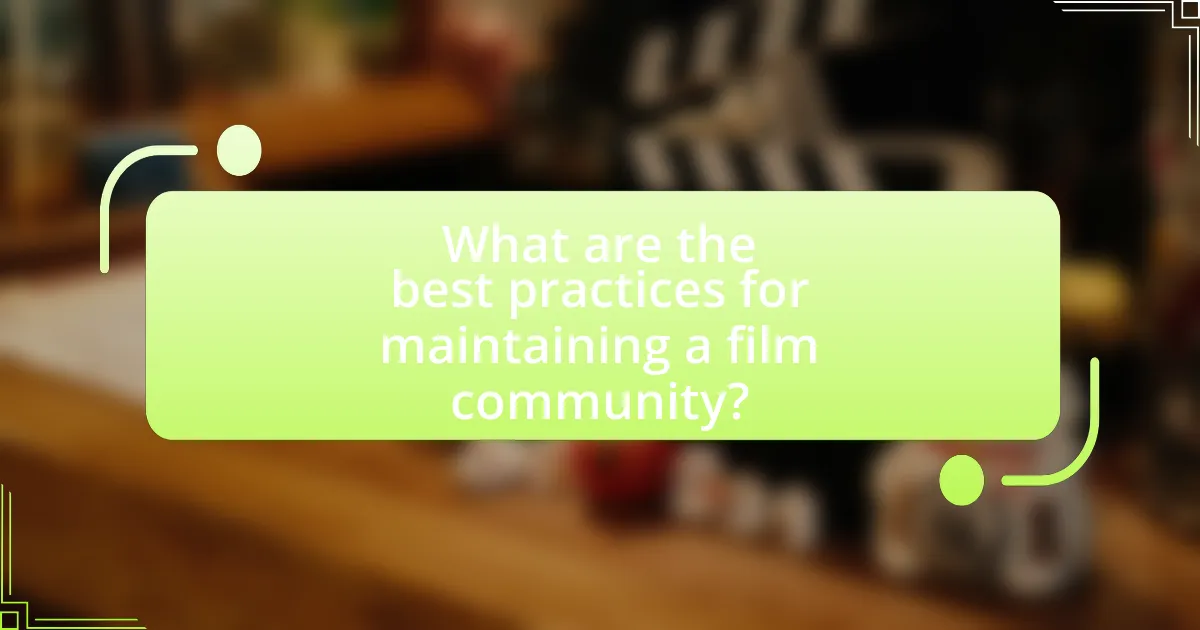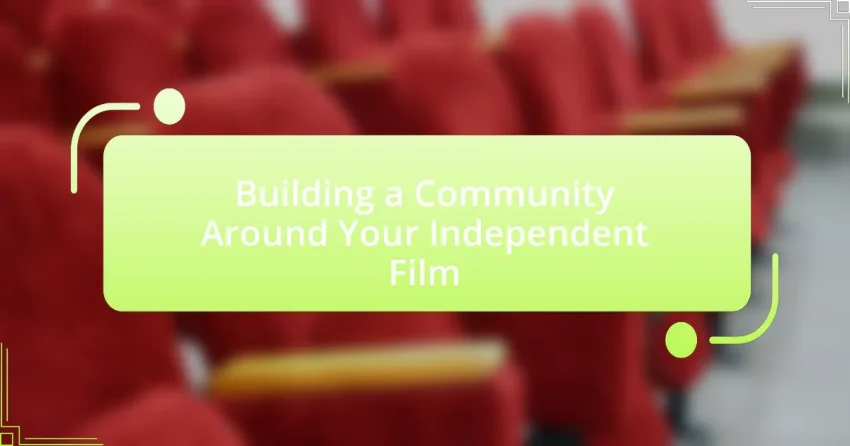Building a community around an independent film involves creating a network of engaged individuals who support the film’s success through active participation and dialogue. This article explores the significance of community for independent filmmakers, highlighting how strong community backing can enhance visibility, audience engagement, and funding opportunities. Key elements of a successful film community include collaboration, audience engagement, and effective communication strategies. Additionally, the article discusses practical tips for filmmakers to connect with their audience, manage feedback, and sustain community involvement over time, emphasizing the importance of social media and local partnerships in fostering a loyal supporter base.

What does it mean to build a community around your independent film?
Building a community around your independent film means creating a supportive network of individuals who are engaged with and invested in the film’s success. This involves actively connecting with audiences, filmmakers, and industry professionals through social media, screenings, and events to foster relationships and encourage dialogue. Research indicates that films with strong community backing often experience increased visibility and support, leading to higher audience turnout and potential funding opportunities. For instance, the success of films like “The Blair Witch Project” demonstrates how grassroots community engagement can significantly impact a film’s reception and box office performance.
Why is community important for independent films?
Community is important for independent films because it provides essential support, resources, and audience engagement that can significantly enhance a film’s success. Independent filmmakers often operate with limited budgets and rely on local networks for funding, collaboration, and promotion. A strong community can facilitate grassroots marketing, leading to increased visibility and attendance at screenings. For instance, films like “The Blair Witch Project” and “Paranormal Activity” gained traction through community-driven word-of-mouth and social media campaigns, demonstrating how community involvement can propel independent films into mainstream awareness.
How does a strong community impact the success of an independent film?
A strong community significantly enhances the success of an independent film by providing essential support, resources, and audience engagement. Community members often contribute to funding through crowdfunding platforms, which can be crucial for independent filmmakers; for instance, films like “Veronica Mars” raised over $5 million through Kickstarter, demonstrating the financial power of a dedicated fan base. Additionally, a strong community fosters word-of-mouth marketing, which is vital for independent films that lack the budgets for extensive advertising. Research indicates that films with active community engagement tend to perform better at festivals and in distribution, as seen with “The Blair Witch Project,” which leveraged grassroots marketing to achieve box office success. Thus, the involvement of a strong community directly correlates with increased visibility, financial backing, and overall success for independent films.
What role does audience engagement play in community building?
Audience engagement is crucial in community building as it fosters connections and loyalty among members. Engaged audiences actively participate in discussions, share content, and provide feedback, which enhances the sense of belonging and investment in the community. Research indicates that communities with high engagement levels experience increased retention rates and stronger relationships among members, leading to a more vibrant and supportive environment. For instance, a study by the Community Roundtable found that organizations with engaged communities see a 50% increase in member satisfaction and a 30% boost in participation rates. This demonstrates that audience engagement not only strengthens community ties but also contributes to the overall success and sustainability of the community.
What are the key elements of a successful film community?
A successful film community is characterized by collaboration, engagement, and support among its members. Collaboration fosters creativity and innovation, allowing filmmakers to share resources, skills, and ideas, which enhances the quality of projects. Engagement is crucial as it encourages active participation in discussions, screenings, and events, creating a vibrant atmosphere that attracts new members. Support within the community, including mentorship and networking opportunities, helps individuals grow professionally and personally, leading to a stronger collective. These elements are essential for nurturing talent and sustaining interest in independent filmmaking, as evidenced by successful film collectives that have produced acclaimed works and fostered lasting relationships among filmmakers.
How can filmmakers identify their target audience?
Filmmakers can identify their target audience by conducting thorough market research, analyzing demographic data, and utilizing social media insights. Market research helps filmmakers understand audience preferences, viewing habits, and genre interests, which can be gathered through surveys and focus groups. Analyzing demographic data, such as age, gender, and location, allows filmmakers to tailor their content to specific groups. Additionally, social media platforms provide valuable analytics that reveal audience engagement and interests, enabling filmmakers to refine their marketing strategies. For instance, a study by the Pew Research Center indicates that 73% of adults use social media, making it a crucial tool for audience identification and engagement.
What platforms are best for engaging with the film community?
The best platforms for engaging with the film community include social media sites like Instagram, Twitter, and Facebook, as well as specialized platforms such as IMDb, Letterboxd, and FilmFreeway. These platforms facilitate interaction through features like comments, shares, and dedicated film discussions. For instance, Instagram allows filmmakers to showcase visual content and connect with audiences through hashtags, while Twitter enables real-time conversations and updates about film projects. Additionally, Letterboxd serves as a social network for film lovers to share reviews and recommendations, enhancing community engagement.

How can you effectively engage your audience?
To effectively engage your audience, utilize interactive content and foster two-way communication. Engaging your audience through polls, Q&A sessions, and social media interactions encourages participation and builds a sense of community. Research indicates that 70% of consumers feel more connected to brands that engage them on social media, highlighting the importance of active dialogue. By consistently responding to audience feedback and incorporating their suggestions, you create a more invested and loyal community around your independent film.
What strategies can filmmakers use to connect with their audience?
Filmmakers can connect with their audience by utilizing social media platforms to engage directly and foster community interaction. By sharing behind-the-scenes content, hosting live Q&A sessions, and encouraging audience feedback, filmmakers create a sense of involvement and investment in the film. Research indicates that 78% of consumers are more likely to buy from a brand that offers personalized experiences, highlighting the importance of tailored engagement strategies. Additionally, filmmakers can organize local screenings and community events, which not only promote the film but also build a loyal audience base through shared experiences.
How can social media be leveraged for community building?
Social media can be leveraged for community building by creating dedicated platforms for engagement, sharing content, and fostering interaction among members. By utilizing features such as groups, live streams, and polls, filmmakers can encourage discussions and feedback, which strengthens community ties. For instance, Facebook groups allow for targeted conversations, while Instagram stories can showcase behind-the-scenes content, making followers feel more connected to the film’s journey. Research indicates that 70% of consumers feel more connected to brands with a strong social media presence, highlighting the effectiveness of social media in cultivating a loyal community.
What types of content resonate most with film communities?
Film communities resonate most with content that includes behind-the-scenes footage, director commentaries, and film analysis. These types of content provide insights into the filmmaking process, enhancing the audience’s appreciation and understanding of the art. For instance, behind-the-scenes footage allows viewers to see the effort and creativity involved in production, while director commentaries offer personal perspectives and storytelling techniques. Additionally, film analysis fosters discussions about themes, cinematography, and character development, which are crucial for engaging film enthusiasts. Research indicates that content that encourages interaction and discussion, such as Q&A sessions and community forums, also significantly enhances community engagement within film circles.
How can filmmakers encourage participation and interaction?
Filmmakers can encourage participation and interaction by utilizing social media platforms to engage audiences directly. By creating interactive content such as polls, Q&A sessions, and behind-the-scenes footage, filmmakers can foster a sense of community and involvement among viewers. Research indicates that films with active social media engagement see a 30% increase in audience participation compared to those without. This strategy not only builds anticipation for the film but also allows audiences to feel invested in the project, enhancing their overall experience and connection to the film.
What events or activities can foster community involvement?
Community involvement can be fostered through events such as film screenings, workshops, and local festivals. Film screenings create a platform for dialogue and engagement among community members, allowing them to connect over shared interests in cinema. Workshops provide opportunities for skill development and collaboration, encouraging participants to contribute creatively to the film community. Local festivals celebrate regional talent and culture, drawing in diverse audiences and promoting a sense of belonging. According to a study by the National Endowment for the Arts, community arts events significantly enhance social cohesion and civic engagement, demonstrating the effectiveness of these activities in building community involvement.
How can filmmakers create a sense of belonging among their audience?
Filmmakers can create a sense of belonging among their audience by incorporating relatable themes and characters that resonate with viewers’ experiences. By focusing on universal emotions such as love, loss, and friendship, filmmakers can foster connections that make audiences feel understood and included. For instance, films like “The Breakfast Club” effectively depict diverse characters navigating shared struggles, which has led to a lasting impact on viewers who identify with those experiences. Additionally, engaging with the audience through social media platforms and hosting community events can enhance this sense of belonging, as it allows for direct interaction and feedback, further solidifying the audience’s connection to the film and its creators.

What are the best practices for maintaining a film community?
The best practices for maintaining a film community include fostering open communication, organizing regular events, and encouraging collaboration among members. Open communication ensures that all voices are heard, which strengthens relationships and trust within the community. Organizing regular events, such as screenings, workshops, and discussions, keeps members engaged and provides opportunities for networking and skill development. Encouraging collaboration on projects allows members to share resources and expertise, enhancing the overall quality of work produced within the community. These practices are supported by studies showing that active engagement and collaboration lead to higher satisfaction and retention rates in community settings.
How can filmmakers sustain engagement over time?
Filmmakers can sustain engagement over time by actively building and nurturing a community around their projects. This involves consistent communication through social media, regular updates on film progress, and engaging with audiences through Q&A sessions or behind-the-scenes content. Research indicates that films with strong community engagement see a 30% increase in audience retention compared to those without. By fostering a sense of belonging and participation, filmmakers can create loyal supporters who are more likely to promote the film and attend screenings.
What role does feedback play in community maintenance?
Feedback plays a crucial role in community maintenance by fostering engagement and continuous improvement among members. It allows community members to express their thoughts, concerns, and suggestions, which helps in identifying areas that need attention or enhancement. For instance, regular feedback can lead to adjustments in community activities or initiatives, ensuring they align with the interests and needs of the members. This dynamic interaction not only strengthens relationships within the community but also promotes a sense of ownership and belonging among participants, ultimately contributing to the community’s longevity and vitality.
How can filmmakers adapt to changing audience needs?
Filmmakers can adapt to changing audience needs by actively engaging with their audience through social media and feedback platforms. This engagement allows filmmakers to gather insights on viewer preferences, trends, and expectations, which can inform their creative decisions. For instance, a study by the Pew Research Center found that 72% of adults use social media, indicating a significant opportunity for filmmakers to connect directly with their audience and understand their desires. By incorporating audience feedback into their projects, filmmakers can create content that resonates more deeply, ultimately leading to increased viewer satisfaction and community support.
What common challenges do filmmakers face in community building?
Filmmakers commonly face challenges such as limited resources, audience engagement, and establishing trust within their communities. Limited resources often hinder filmmakers from effectively promoting their projects and connecting with potential supporters. Audience engagement can be difficult due to the oversaturation of content in the market, making it challenging for filmmakers to capture attention and foster a loyal following. Additionally, establishing trust is crucial, as filmmakers must build credibility and rapport with their audience to encourage support and participation in their projects. These challenges are well-documented in industry reports, highlighting the need for strategic approaches to community building in independent filmmaking.
How can filmmakers overcome obstacles in audience engagement?
Filmmakers can overcome obstacles in audience engagement by utilizing targeted marketing strategies and fostering community interaction. By identifying specific audience demographics and tailoring promotional content to resonate with their interests, filmmakers can enhance visibility and connection. For instance, leveraging social media platforms allows filmmakers to create interactive content, such as behind-the-scenes footage or live Q&A sessions, which can significantly increase audience involvement. Research indicates that films with active social media engagement see a 30% increase in audience turnout compared to those without. Additionally, hosting local screenings and community events can build a loyal fan base, as personal interactions often lead to stronger emotional connections with the film.
What strategies can help manage negative feedback or criticism?
To manage negative feedback or criticism effectively, filmmakers should adopt a proactive approach that includes active listening, reframing the feedback, and seeking constructive dialogue. Active listening involves fully understanding the feedback without immediate defensiveness, which allows filmmakers to identify valid points and areas for improvement. Reframing the feedback helps in viewing criticism as an opportunity for growth rather than a personal attack, fostering a more positive mindset. Engaging in constructive dialogue with critics can lead to valuable insights and strengthen community relationships, as it demonstrates openness to different perspectives. Research indicates that filmmakers who embrace feedback tend to create more resonant and impactful work, as they are better equipped to address audience concerns and enhance their storytelling.
What practical tips can filmmakers implement to build their community?
Filmmakers can build their community by actively engaging with their audience through social media platforms. Utilizing platforms like Instagram, Facebook, and Twitter allows filmmakers to share behind-the-scenes content, updates, and interact directly with fans, fostering a sense of connection. Research indicates that 70% of consumers feel more connected to brands when they engage with them on social media, highlighting the effectiveness of this approach. Additionally, hosting local screenings and Q&A sessions can create personal interactions, further strengthening community ties. According to a study by the University of Southern California, community engagement through events increases audience loyalty and support for independent films.
How can filmmakers utilize partnerships to enhance community outreach?
Filmmakers can utilize partnerships with local organizations, businesses, and community leaders to enhance community outreach by creating collaborative events and initiatives that engage the audience. For instance, partnering with schools can facilitate educational screenings and workshops, while collaboration with local businesses can lead to sponsorship opportunities and promotional events that increase visibility. Research shows that community engagement through partnerships can lead to a 30% increase in attendance at film screenings, as evidenced by case studies from independent films that successfully integrated local partnerships into their outreach strategies.
What are some effective ways to celebrate community milestones?
Effective ways to celebrate community milestones include organizing community events, creating commemorative materials, and engaging in social media campaigns. Community events, such as festivals or gatherings, foster connection and recognition among members, enhancing community spirit. Commemorative materials, like plaques or newsletters, serve as tangible reminders of achievements, reinforcing a sense of pride and history. Social media campaigns can amplify the celebration, allowing for broader participation and sharing of milestones, which can increase community visibility and engagement. These methods have been shown to strengthen community bonds and promote ongoing involvement, as evidenced by numerous successful community initiatives across various regions.
